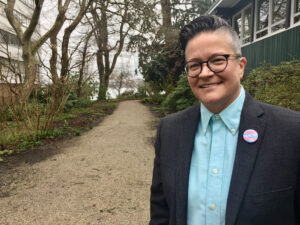
Lisa Helps is the former Mayor of the City of Victoria and current housing solutions adviser to the Premier of British Columbia.

Megan Meaney is the Executive Director of ICLEI Canada with whom CUI is partnering for their Annual Livable Cities Forum.

Jennifer Angel is CUI’s Placemaking Fellow and CEO of Evergreen. 
Donnie Rosa is General Manager of the Vancouver Board of Parks and Recreation.
Peter Sloly is CUI’s Community Safety Fellow and former Chief of Police for the City of Ottawa.
Leilani Farha is a CUI Housing Fellow and Global Director of The Shift and Julieta Perucca is Deputy Director of The Shift.

Dr. Carolyn Whitzman is a senior associate with CUI, housing and social policy consultant, and expert advisor to the HART (Housing Assessment Resource Tools) project, which breaks down core housing need by income category, household size, and priority population. |
Jean Noé Landry is CUI’s Climate Data and Governance Fellow, a Senior Strategic Advisor for the Inter-University Climate Data Studio at Concordia University, and an early leader in the civic tech movement.

Dorian Moore is CUI’s Urban Design Fellow, lives in Windsor, Ontario, and works as an architect and urban designer in Detroit, Michigan.
Multisolving the polycrisis
The World Economic Forum uses the term “polycrisis” to describe “a cluster of related global risks with compounding effects, such that the overall impact exceeds the sum of each part.”
Canadian cities are facing an urban polycrisis at the local scale due to the climate crisis, the housing crisis, the opioid crisis, the cost of living, increasing inequality, polarization, systemic racism, and spiraling infrastructure and climate adaptation costs. City policymaking in the months and decades to come must multisolve for the polycrisis, meaning municipal policies must address more than one issue. It’s an efficient, fiscally prudent, and inspiring approach.
Cities often cite lack of resources and inadequate authority as key challenges to taking action on these intersecting, compounding crises. This isn’t going to change in the short term. And right now, given the dire situation outlined in the recent IPCC report (Intergovernmental Panel on Climate Change), the short term is all we have.
So, how are city leaders to multisolve with limited power and resources?
First: use their extraordinary power to convene. When the mayor calls a meeting, the people invited will most likely attend. Cities can bring together people with diverse – and sometimes conflicting – views, get a shared commitment, and take action. During the pandemic, this convening power worked wonders in Victoria both to help address homelessness and to help keep our local businesses afloat.
Second: yes, cities need to continue to advocate to the provincial and federal governments for predictable, stable funding. Yet to multisolve, cities must also use their creativity, develop unexpected partnerships, and create new financial models to muster the financial resources necessary to renew infrastructure, reduce GHGs, adapt to climate change, and enhance the wellbeing of residents. The MaRS Municipal Impact Investment Fund is one emerging example.
Third: cities shouldn’t worry too much about the authority they don’t have, but rather, have the courage and risk tolerance to work at the very edges of the authority they do have. Even if that authority is challenged, it can lead to large scale change. We saw this in Victoria when the City created Canada’s first reusable bag bylaw. This led to multiple court challenges that ultimately found that the City had exceeded its authority. But the whole ordeal pushed the provincial and federal governments to move more quickly to reduce single use plastics.
Finally, cities need to bring everyone along.
If we are supporting climate friendly housing but only the wealthy can afford it;
If we have Equity, Diversity and Inclusion offices but don’t see diversity and inclusion in senior positions in city administration;
If we have climate adaptation plans that don’t account for people experiencing homelessness living in tents …
Then we may not be multisolving.
– Lisa Helps
|
Canadian cities on the world stage
I’ve always been of the opinion that Canadian cities punch above their weight when it comes to representation on the world stage on issues relating to climate change. Maybe it’s because Canada has the longest running municipally focused climate mitigation and adaptation programming in the world. Maybe it’s because our cities have hosted more ICLEI (International Council for Local Environmental Initiatives) World Congresses than any other country. Or maybe it’s because I’m Canadian and I’m biased. Whatever the reason, now is not the time for complacency.
Given the scale of the challenge and the pace of climate impacts, we must continue to innovate and drive toward net-zero emissions with our international peers. On the international front, 2024 is a busy year – a year when we must find and seize the opportunity.
While headlines regarding President Biden’s visit to Ottawa in late March 2023 focused on renewed cooperation and partnership between Canada and the US, work is already underway to support these high-level commitments. At the end of April 2023, the Biden administration hosts the Cities Summit of the Americas in Denver, convening local leaders from across the Western Hemisphere to promote regional cooperation. This will create an unprecedented opportunity for local governments, businesses, and community organizations to collaborate and develop new solutions to the most pressing climate issues facing cities.
In October 2023 in Montreal, the international climate adaptation conference series known as Adaptation Futures is bringing together researchers, policymakers, practitioners, industry representatives, and communicators to present their latest research with a goal to accelerate the adoption of transformative adaptation for long-term resilience.
We also have the G7 (Group of 7) process that brings together the world’s advanced economies to influence global trends and tackle pervasive and crosscutting issues. In 2021, a complimentary G7 Urban7 (U7) process was launched to advocate for a continuous dialogue between the G7 nations and municipal actors; one of its objectives being to elevate climate-neutral urban development practices. In 2023, they meet in Japan; next year, in Italy; and in 2025, these international deliberations come to Canada.
It is incumbent upon us – along with each and every participant, organizer, funder and speaker in these events – to ensure we seize the collective moment, particularly after the initial press has died down. Let us rise to the occasion and ensure these international events on Canadian soil are clear milestones in our collaborative progress toward addressing the climate crisis.
– Megan Meaney
Great cities have great public spaces
The recent federal budget is among the most aggressive ever for green and clean investment. Previous investments in housing through CMHC (Canada Mortgage and Housing Corporation) programs, the $4B Housing Accelerator Fund and others, the ICIP (Investing in Canada Infrastructure Program), Low Carbon Economy Fund, and the Green and Inclusive Community Buildings program continue to be implemented, some with promising impact.
Now is the time to focus these public infrastructure investments on cities.
Cities are home to close to 60% of the world’s population and are expected to grow to over 70% by 2050 – they are powerful levers for change. They need to be prioritized for infrastructure investment and that infrastructure needs to work harder for people and planet.
Great cities have great public spaces, providing the conditions for gathering and strengthening our communities, building understanding and trust, contributing to climate resilience and regeneration, and improving our health and wellbeing. Great public spaces support sustainable housing solutions and they attract people, including the talent and necessary customers for a thriving economy. Infrastructure shapes the way we live, how we move, who gets to participate, and the extent to which we are extracting from or contributing to the health and wellbeing of our communities and the planet.
In cities across the country, our public realm is crumbling. Revitalizing it is critical to a revitalized social contract and to bring people together across neighbourhoods and sectors … to build a better future for us all.
We need all orders of government, private sector, and community working together in new ways, with a spirit of innovation and collaboration, grounded in trust. The solutions we need and the opportunities before us require tools and expertise and commitment from us all. As we draw new policy and make unprecedented investment in infrastructure, including investments we hope are yet to come, let’s incentivize and reward those who are solving the problems before us, not those who are contributing to them.
We need to build places that bring people together with nature and each other in our cities. By making infrastructure investments work harder, we can build cities for a future where people and nature can thrive. It is an important place to start.
– Jennifer Angel
Resilience and livability: a funding partnership for parks
The City of Vancouver is located on the unceded and ancestral territories of the Musqueam, Squamish, and Tsleil-Waututh peoples and is world renowned for its waterfront seaside pathways, shorelines, and beaches. These assets include 23 kilometres of built seawall and marine structures, including the Stanley Park and English Bay seawalls (some sections of which are more than 100 years old), waterfront restaurants, concessions and washrooms, destination seaside aquatic facilities, and foreshore, piers, docks, and marinas. These stellar waterfront spaces are public amenities and are also protection for the built assets of the city on the lands behind.
Park infrastructure is repeatedly impacted by climate change, including increasingly severe weather and major storms events combined with winter king tides and coastal flooding. Emergency repairs following these events cost taxpayers millions of dollars annually. There is a pressing need to rethink the coastal interfaces and to rebuild for resiliency and for nature.
In Vancouver, we have seen that when contemporary marine structural engineering standards are applied to the design and construction of new seawall sections, these sections can withstand extreme atmospheric events and serve the communities for decades into the future. Investment is essential – especially for our coastline – otherwise, we will be spending year after year to replace the same damaged infrastructure and park assets.
While we are considering the impacts of climate change, it is imperative that we engage the local Nations to explore long-term solutions for resilient shores. Coastal ecological health should be at the forefront when we are addressing impacts and applying new technologies that are climate friendly and costly, however effective. The City of Vancouver, like other cities, is challenged to fund such initiatives. Senior level government funding support for climate resiliency and reconstruction is paramount.
– Donnie Rosa
Improving community safety and wellbeing for all Canadians
From an article covering the official start to the City of Toronto’s 2023 mayoral by-election:
“… mayoral hopefuls took turns framing themselves as the only challenger capable of tackling growing costs of living, deteriorating city services and that have stoked fears Toronto is a city in decline” (https://www.thestar.com/news/city_hall/2023/04/03/torontos-mayoral-election-officially-begins-today.html)
So, crime, policing, and public safety are election priorities in Canada’s biggest city. Meanwhile, a host of ongoing community safety and wellbeing crises (housing, opioids/fentanyl, mental health, etc.) are plaguing every urban and suburban community from coast to coast.
Yet there was almost no reference to such issues in the latest federal budget.
Here are three things the federal government could have announced (and could still) to improve community safety and wellbeing for all Canadians:
Number one: Only approve federal transfer payments and grants related to the police and justice system to provinces/territories that demonstrate effective implementation of the relevant recommendations from the federal commissions: Truth & Reconciliation Commission, the Missing and Murdered Indigenous Women and Girls, the Mass Casualty Commission, etc.
Number two: Require 25% of all federal transfer payments and grants to be allocated to non-police organizations that are directly involved in integrated service delivery programs operating in the pre-criminal space (e.g., Surrey Mobilization and Resiliency Table (SMART) in BC) and alternative response to police programs for persons in crisis that focuses on health, prevention, community safety, and well-being (e.g., Toronto Community Crisis Service — TCCS).
Number three: Require the RCMP in all its contract policing locations in Canada to prioritize and directly support locally integrated service delivery programs operating in the pre-criminal space (e.g., Surrey Mobilization and Resiliency Table (SMART) in BC) and alternative response to police programs for persons in crisis that focuses on health, prevention, community safety, and well-being (e.g., Toronto Community Crisis Service — TCCS).
– Peter Sloly
Cities, leadership, and the housing crisis
The increasing scarcity of affordable rental housing and rising homelessness in cities big and small is a stubborn problem that is undermining the vibrancy, functioning, and resiliency of our cities. Too many people are living in parks, on city sidewalks, and in public transit hubs. Tenants are suffering acute anxiety about the next rent hike or being evicted from their homes which are being “re-positioned” by institutional investors and then displaced outside their communities. We’ve seen hundreds of deaths across Canada of those living in homelessness or inadequate housing due to extreme heat waves and cold snaps.
To tackle the gravity and pervasiveness of the housing crisis and its intersection with the climate crisis, we need an inter-jurisdictional approach, with the Federal and Provincial governments at the helm, providing robust investments and creative solutions. At present, both orders of government have mostly failed to show up in a meaningful way, leaving municipal governments to pick up the reins. And while many have tried to address the housing crisis, city governments are coming up short, arguing that they do not have the jurisdiction or resources to lead.
But leadership is about much more than power and money. Leadership is about having a vision and being bold enough to express that vision; it’s about being creative with available resources; and it’s about taking calculated risks.
We yearn to see Canadian mayors step up and offer a bolder, forward-looking vision about their cities but also about the kind of country they want to help create. Mayors have the capacity to collectively assert that as the 9th largest economy in the world and one of the world’s biggest polluters, ours must be a nation of people who – regardless of income level, or any other personal characteristic – have secure, sustainable and affordable housing. With this as a foundation, they can conceive of new approaches to address the housing crisis, understanding that it that cannot be solved at the expense of the planet and will not be solved by private actors unless they are required to radically change their business practices.
There are so many bold and creative moves cities could make! City councils could enact tenant regulations imposing rent freezes and eviction moratoriums, and in the face of litigation, defend the human rights of their residents. Municipalities could regulate what gets built and where, ensuring any new construction – in light of its heavy footprint – is limited to meeting actual data-driven need and is connected to existing services and infrastructure. Stranded assets like empty office buildings and often vacant units like AirBnBs could be harnessed and refurbished as green opportunities to provide social and deeply affordable housing to those most in need.
With the pandemic still raging globally, no end in sight to wars and conflicts in hotspots around the world, and with just a decade left before the damage done to the planet is irreversible, one gets the sense that cities have nothing to lose and everything to gain by leading in new and bold ways.
– Leilani Farha and Julieta Perucca
Waiting for the great leap forward
Flashback to 2015. Justin Trudeau has just been elected Prime Minister of Canada, with a platform promising transformational action on climate change from an equity perspective. A commitment of $120 billion – one third each on affordable housing, sustainable transport, and energy retrofit – plus a return to a national housing strategy after three decades of neglect equalled a very exciting start for cities!
Flash forward eight years. By 2023, numerous federal reports have concluded that the basic pre-conditions of an effective national housing strategy are missing. These include:
Firstly, the absence of a shared definition of “affordable housing” within federal programs and between levels of government,
Secondly, the disconnection between national 10-year targets (530,000 households out of 1.7 million lifted from core housing need, halving the number of 25,000 chronically homeless individuals) and any monitoring of outcomes,
Thirdly, no basic sense of who needs housing, at what cost, and where – details that are essential to a rights-based approach, including breaking down core housing need by income category/maximum affordable housing cost, household size, and priority populations (e.g., Indigenous, women-led households, people living with disability),
Surely COVID-19 has taught us that rapid transformational change is both possible and necessary. The Canada Emergency Response Benefit almost single-handedly reduced rates of core housing need in the 2021 census for the first time since 1991, showing how essential basic income supports are to affordable housing. But alas, this income benefit was temporary, as were provincial/territorial eviction moratoriums. The importance of adequate shelter to saving lives was evident, too, in doubled death rates in long-term care homes run for profit and the growth of encampments as a terrible alternative to overcrowded and unsafe emergency shelters.
Affordable, accessible, well-located, and energy efficient homes are necessary to address GHG (greenhouse gas) emissions in an equitable and sustainable way. Canada could be creating the technologies and programs it needs to reverse alarming trends in GHG emissions. We have the wealth and we have the knowledge. What continues to be missing is political will to walk the talk.
– Dr. Carolyn Whitzman|
Fixing the granularity deficit
If they haven’t already, cities are fast adopting climate plans and roadmaps to reduce their GHG (greenhouse gas) emissions and strengthen their resilience to climate change. From municipal administrations and their provincial counterparts to corporate social and environmental responsibility plans and civil society, a broad diversity of actors is engaged in transformative institutional and behavioural changes. However, few local contexts have adopted data strategies to support the enabling conditions for this cross-societal call to action – data strategies that must be collaborative, multi-sectoral, multi-scale. This is partly because human and digital interoperability is daunting, and few local stakeholders possess the mandate, credibility, and knowledge to facilitate it.
Indeed, Canadian cities face a lack of information that hinders the development of new policies and practices as well as the continuous improvement of current measures, cross-sectoral collaboration, and the socio-ecological changes needed at the local level. If global GHG emissions are known, as well as their distribution by sector, we often lack the required granularity to be able to effectively transform the emission sources that have the most impact on our collective balance sheet. This granularity deficit affects a variety of sectors, including the transportation of people and goods, buildings, as well as direct measurement of emissions using satellite sensors and indirect measurement methods facilitating “bottom-up” and compiled emissions estimates.
Urgency is growing to build the necessary collaborative infrastructure and capacity to share digital data and to reach agreement on shared objectives that will facilitate inter-systemic and inter-sectoral collaboration. Emissions dashboards, such as the Data Portal For Cities, the Canadian Climate Institute’s 440 Megatonnes, and the Greater Toronto and Hamilton Area Carbon Inventory, are critical digital infrastructure centred on building transparency, accountability, and analytical capacity. Meanwhile, innovative municipal open urban platforms like twin cities (e.g., City of Rotterdam) can serve to represent real-time emissions data. Because climate change compels us to think and plan across siloes and jurisdictions, such digital climate infrastructure must strike a balance between being locally adapted and permitting comparative analysis and collaboration.
Further, leveraging local private, public, civic, institutional, and philanthropic partnerships, such as the Montreal Climate Partnership (MCP) are key. The MCP supports multi-stakeholder efforts to map ecosystemic data to identify emissions data gaps and access barriers, define shared objectives. It includes a wider diversity of user groups in developing the necessary collaborative data governance and data management policies, procedures, and protocols.
Following good tech design principles, collaborative emissions dashboards should focus on a clear set of objectives and not start from the basis of a given solution. It is the why that will generate important conversation on data publication and sharing incentives with a focus on intra/inter-sectoral and sectional data analysis with direct implications for local behavioural change and collective impact in support of data-driven municipal climate action plans.
– Jean Noé Landry|
Investing in neighbourhoods, districts, and corridors
COVID-19 displayed for us, firsthand, the importance of public outdoor gathering places. Building on this, Canadian municipalities should invest in a three-pronged, public space-based approach to strengthening our neighborhoods, districts, and corridors.
Prong one: create and enhance public spaces that are within a 5-minute walk of residential or business areas.
Public space should be centrally located and at each edge of the targeted area to benefit the high street shops and overall neighbourhood, district, or corridor . This also needs to attract the remote workers who live downtown. Public spaces need to be incorporated into walkable neighbourhoods, districts, and corridors. To do this, there should be a focus on the pedestrian facilities that connect to the public space. Creating and budgeting for sidewalks, street crossings, accessibility accommodations, and the maintenance of the items is critical.
Prong two: determine a niche around which to build an identity for the neighbourhood, district, or corridor.
Identify each area’s assets: landmarks, visual character, and significant history. Create specialized promotional campaigns to solidify the identity in the minds of the general public. Concentrate on livability (for existing and new residents) rather than visitability (for tourists).
Prong three: promote the Social-Place aspects of the neighbourhood, district, or corridor.
Create the right conditions for amenities (beyond coffee shops) that bring people to a neighborhood, district, or corridor. Concentrate on creating live, work, and play environments that surround and support public spaces. Examples of these fine grain amenities include:
- Health and Wellness: exercise, pilates, yoga
- Entertainment: local-themed restaurants and pubs
- Aesthetics: hair and beauty salons
These amenity types can serve as third places for a community. Commonalities that bring together peoples of disparate backgrounds. The more interaction between people of differing backgrounds, the more comfortable they become with each other.
– Dorian Moore



